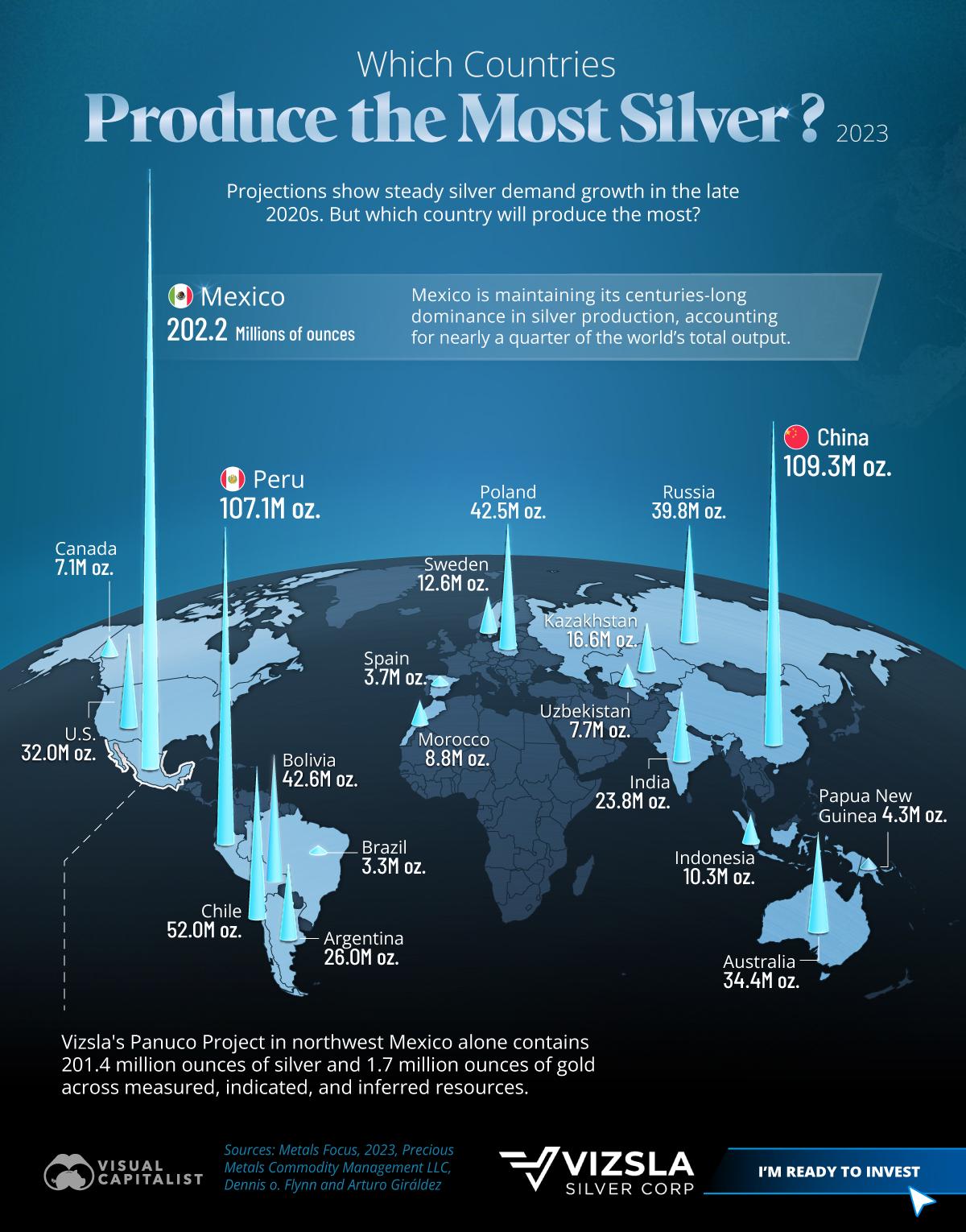Silver Production by Country Map 2023


Alex Cartwright
Senior Cartographer & GIS Specialist
Alex Cartwright is a renowned cartographer and geographic information systems specialist with over 15 years of experience in spatial analysis and data...
Geographic Analysis
What This Map Shows
The map titled "Which Countries Produce the Most Silver? 2023" visually represents the leading silver-producing countries in the world for the year 2023. It provides a clear and detailed snapshot of silver production levels, highlighting the top producers and their respective contributions to the global silver market. By examining this map, we can gain valuable insights into the geographical distribution of silver mining and its importance to various economies.
Deep Dive into Silver Production
Silver, known for its unique properties and versatility, is a metal that has been valued for centuries. It's utilized in various applications, from jewelry and electronics to solar panels and medical instruments. The production of silver is primarily concentrated in a few key countries, which dominate the global supply chain.
As of 2023, Mexico continues to be the world’s largest silver producer, contributing around 190 million ounces annually. Mexico's rich mining history, coupled with its favorable geological conditions, makes it ideal for silver extraction. The country’s silver mines are often found in mountainous regions, where significant silver deposits can be located.
Following Mexico, Peru stands out as the second-largest producer, with an annual output of approximately 120 million ounces. The silver mining industry in Peru is crucial not only for its economy but also for employment. Interestingly, many of Peru’s mines are located in the Andes mountains, where both silver and other precious metals such as copper can be found in abundance.
China ranks third in silver production, with around 100 million ounces produced each year. The rapid industrial growth in China has increased its demand for silver, particularly in technology and manufacturing sectors. What’s fascinating is that many of China’s silver mines are actually by-products of copper and lead mining, showcasing the interconnected nature of mineral extraction.
Other notable silver-producing nations include Russia and Chile, which together contribute significantly to the global silver supply. Russia's silver output is largely driven by its vast natural resources, while Chile—known primarily for copper—also produces a substantial amount of silver as a by-product.
Furthermore, the United States has a long history of silver mining, particularly in states like Nevada and Alaska, where significant deposits can still be found. Although its production has decreased compared to the peaks of the past, the U.S. remains an important player in the silver market.
Regional Analysis
In examining the regions depicted on the map, it’s clear that the Americas are at the forefront of silver production. Mexico and Peru dominate the landscape, while the United States also contributes to the North American output. However, South America is not just about Peru; countries like Bolivia and Argentina also play a role, albeit smaller, in the silver production scene.
In contrast, Europe and Asia see lower silver production levels, with only Russia making a notable impact in Europe. What's interesting is that many European countries have limited mining activities due to environmental regulations and a shift towards sustainable practices.
Comparing the production levels, it’s evident that Mexico’s output dwarfs that of many other countries, leading to questions about the sustainability of such high levels of extraction. The environmental impact of silver mining, especially in sensitive ecosystems, is a growing concern and has led to increased scrutiny and calls for more responsible mining practices.
Significance and Impact
Understanding silver production is vital not only for economic reasons but also for its implications on global markets and environmental sustainability. Silver plays a crucial role in various industries, and its price can significantly affect economies, especially in countries that rely heavily on mining.
Interestingly, the global demand for silver is expected to rise, particularly due to its applications in renewable energy technologies. As the world shifts towards greener energy solutions, the need for silver in solar panels and battery technology will likely increase. This trend could lead to further exploration and mining activity in the top-producing countries, raising questions about environmental and ethical mining practices.
In conclusion, the map of silver production by country in 2023 not only highlights where the metal is mined but also opens up discussions about the future of mining, sustainability, and the interconnected nature of global economies. The silver industry is at a crossroads, and how producing countries respond to these challenges will shape the market for years to come.
Visualization Details
- Published
- August 17, 2025
- Views
- 126
Comments
Loading comments...